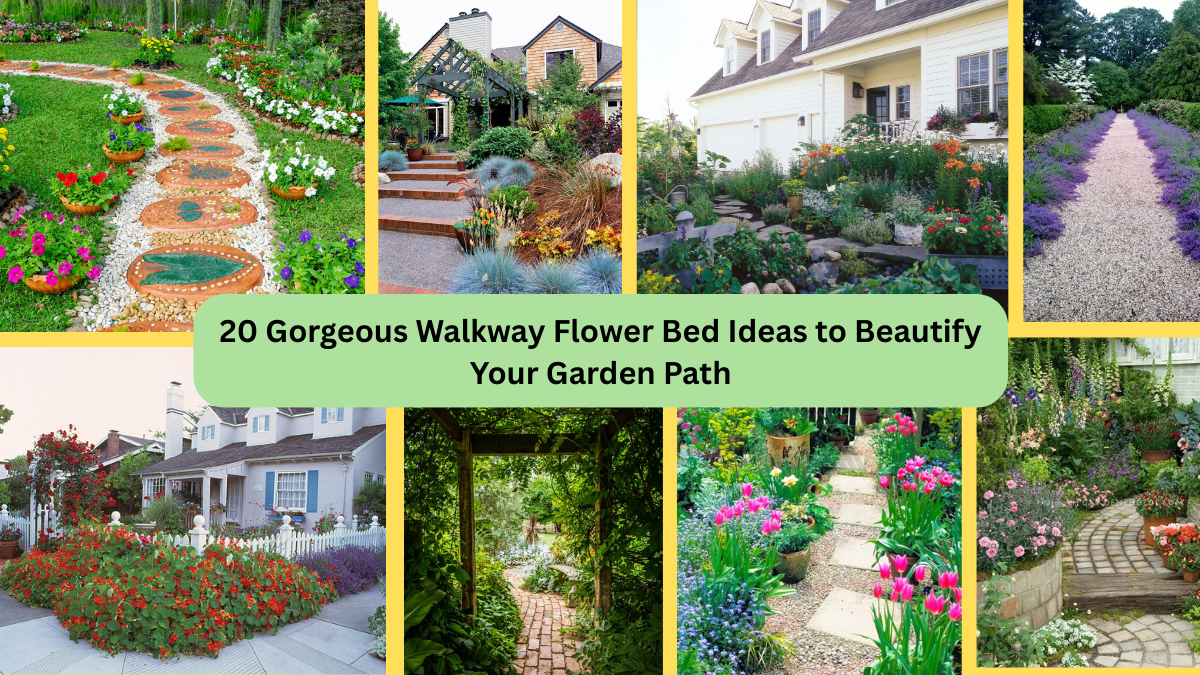Your garden walkway isn’t just a path it’s an opportunity to make a stunning first impression. Whether leading to your front door, winding through a backyard oasis, or connecting different outdoor spaces, a beautifully bordered path sets the tone for your entire garden. One of the most charming ways to elevate your walkway is by adding vibrant, thoughtfully designed flower beds.
From romantic cottage-style blooms to modern minimalist arrangements, walkway flower beds can transform an ordinary path into a blooming masterpiece. In this article, we’ll explore 20 gorgeous walkway flower bed ideas to inspire your next garden makeover. Whether you’re working with sun or shade, curves or straight lines, bold color or subtle elegance—there’s a perfect flower bed idea here for every garden lover. Let’s dig in!
1. Classic Border Bloom
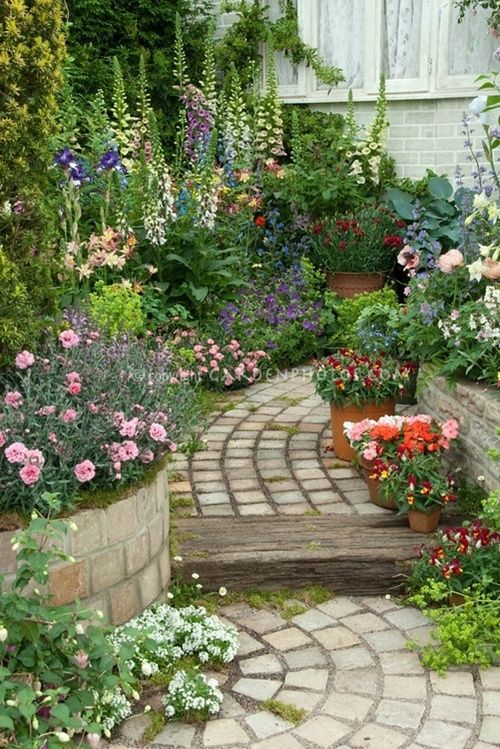
Add timeless elegance to your walkway with classic border blooms like petunias, marigolds, and pansies. These low-growing flowers create a neat, colorful line along your garden path, offering continuous blooms throughout the seasons. Choose a mix of colors or go monochromatic for a more sophisticated look. This design is easy to maintain and perfect for traditional or cottage-style gardens. Pair with a mulch or stone base for contrast and added charm.
2. Lavender Lined Paths
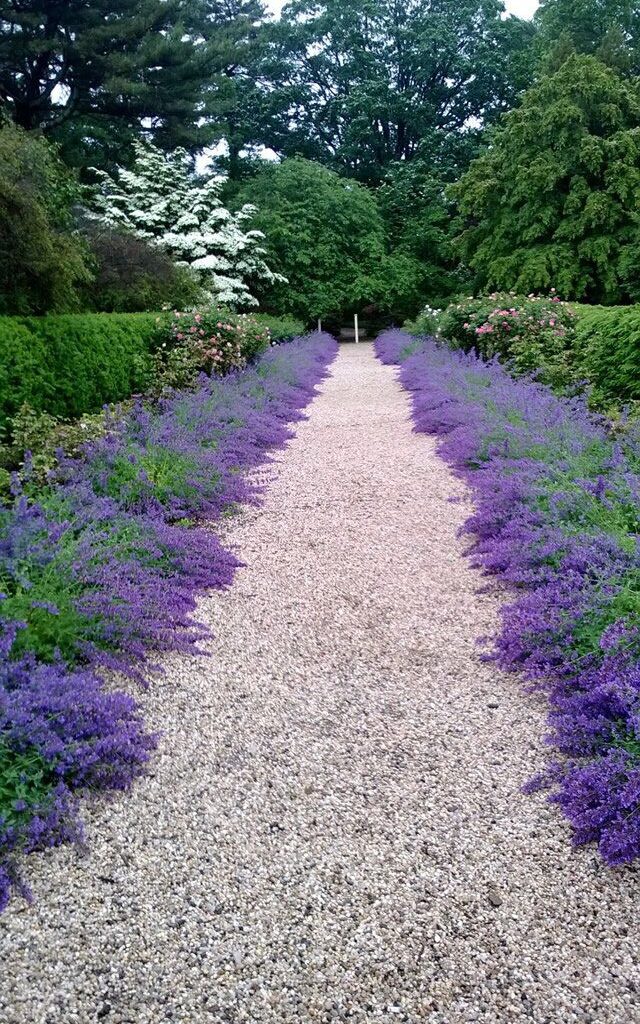
Create a serene and fragrant experience by planting lavender along your walkway. Lavender’s purple blooms and soothing scent make it ideal for a calming garden path. It also attracts pollinators like bees and butterflies, enhancing your garden’s ecosystem. Drought-tolerant and low-maintenance, lavender adds a touch of Mediterranean beauty and grows well in full sun with well-drained soil. The silvery foliage also adds texture and color contrast to your garden.
3. Wildflower Wonderlan

For a natural, free-spirited aesthetic, line your walkway with wildflowers such as coneflowers, black-eyed Susans, and cosmos. This idea brings a burst of color and encourages biodiversity, drawing in butterflies and hummingbirds. Let the flowers spill slightly over the path for an inviting, whimsical touch. Wildflower beds are low-maintenance once established and thrive with minimal intervention, making them perfect for eco-conscious gardeners who love a touch of organized chaos.
4. Tropical Foliage & Bright Blooms

If you’re after a bold, lush look, consider tropical plants like canna lilies, elephant ears, and hibiscus to flank your walkway. Their large leaves and vibrant colors create a dramatic visual impact. These plants thrive in warm climates and love full sun and moisture. Combining bright blooms with unique foliage will make your garden path feel like a vacation getaway. Use darker mulch or stone to highlight the vivid greenery and floral colors.
5. Cottage Garden Mix

The cottage garden style is all about charming disarray. Combine hollyhocks, delphiniums, daisies, and roses for a romantic flower bed flanking your walkway. The mixture of heights, colors, and textures gives the feel of a storybook garden. Let the flowers grow slightly over the edge for an effortless, cozy vibe. Incorporate winding paths and rustic stone edging to complete the look. This design thrives with a mix of sun and partial shade.
6. Edible Herb & Flower Combo

Why not combine beauty with function? Line your walkway with a delightful mix of herbs and edible flowers like basil, thyme, calendula, and nasturtiums. These plants not only smell amazing as you walk by, but also serve as fresh ingredients for your kitchen. Nasturtiums, in particular, add a pop of color while being completely edible. The mix of green herbs and vibrant blooms offers a unique sensory experience and is perfect for eco-friendly, functional gardening.
7. Monochrome Flower Beds

Sometimes simplicity is the key to elegance. Choose one color palette—such as all whites, purples, or pinks—and plant flowers in varying shapes and sizes along your walkway. For example, mix white tulips, daisies, and alyssum for a crisp, cohesive look. Monochrome flower beds offer a sophisticated appearance and help unify your garden design. This idea is ideal for modern gardens or minimalist landscapes where harmony and visual consistency are essential.
8. Ornamental Grasses & Blooms
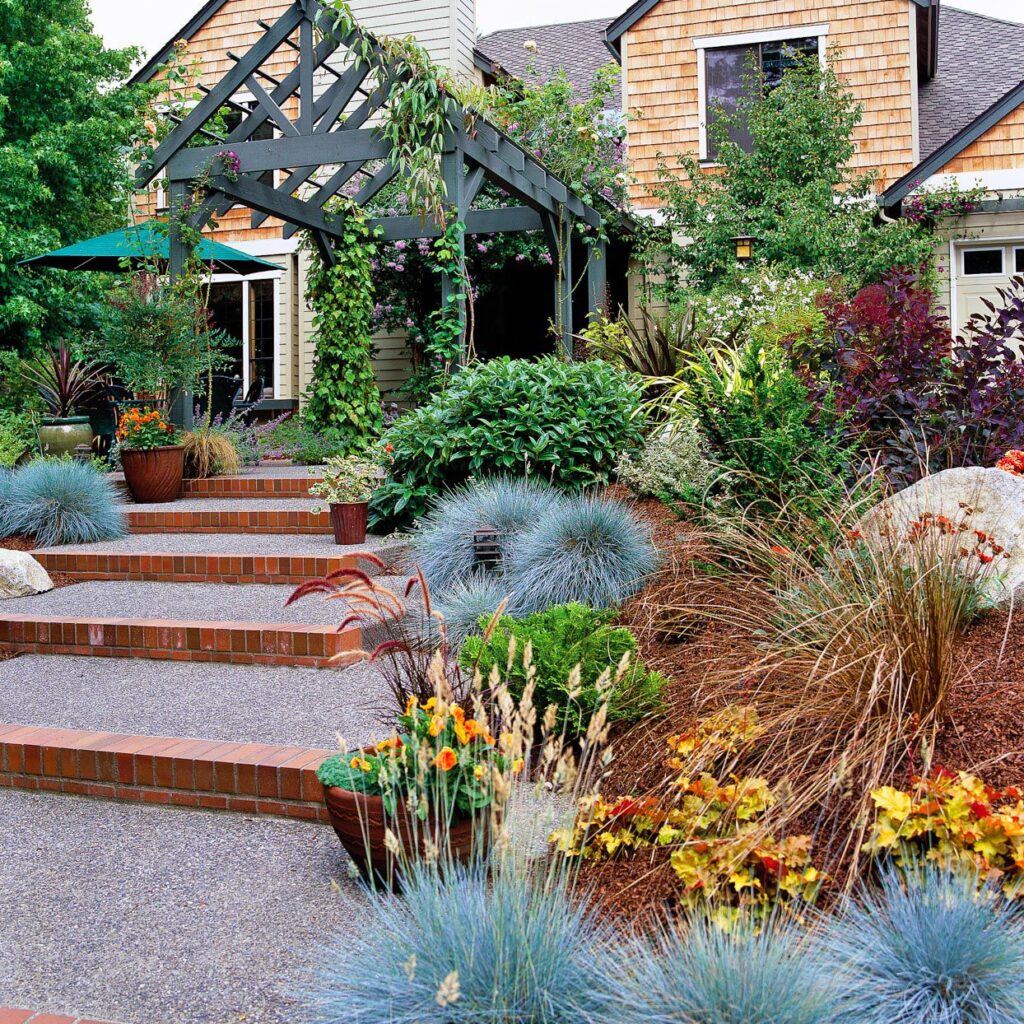
Blend ornamental grasses like fountain grass or blue fescue with colorful flowers such as coreopsis, daylilies, or salvia. The movement of the grasses in the wind paired with the bright blooms creates a dynamic, textured look along your garden path. This combination brings year-round interest with easy upkeep and drought tolerance. It’s an excellent option for contemporary gardens or anyone looking to soften hardscaped paths with natural, flowing beauty.
9. Rock Garden Flower Borders

Incorporate small rocks and succulents with flowering plants like sedum, hens and chicks, or ice plant to build a rock garden-style walkway. This low-maintenance and water-wise idea adds a unique desert-inspired charm. The contrast between rough stones and delicate flowers gives the path character. Use colored pebbles or decorative boulders to enhance the appeal. Perfect for arid climates or gardeners who want a unique twist on traditional flower beds.
10. Seasonal Bloomer Path
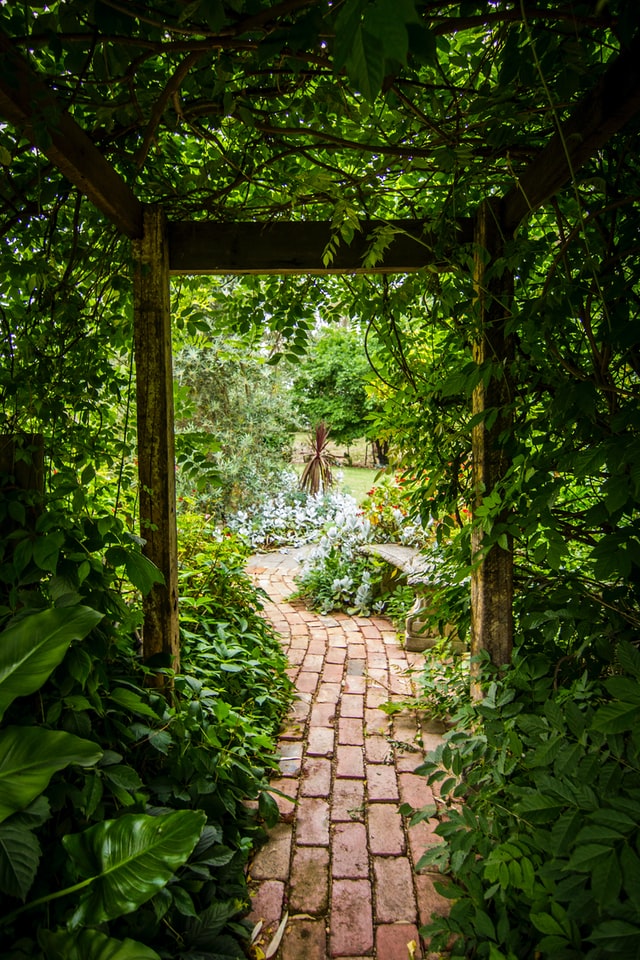
Keep your walkway flower beds vibrant year-round by planting seasonal bloomers in layers. Use bulbs like tulips and daffodils in spring, daisies and coneflowers in summer, chrysanthemums in fall, and ornamental cabbages or pansies in winter. Layering ensures there’s always something blooming along your path no matter the season. This idea requires a bit of planning but results in a constantly evolving and engaging walkway garden experience.
11. Fragrant Flower Borders

Turn your garden walk into a sensory escape by using fragrant flowers like gardenias, lilies, jasmine, and sweet alyssum. These plants fill the air with pleasant aromas as you pass by, making your strolls especially delightful in the early morning or evening. Combine different bloom times and fragrances for continuous scent variation. Pairing them with soft lighting or lanterns can elevate the ambiance even more.
12. Zen-Inspired Floral Path

Create a tranquil, minimalist path with a Zen garden aesthetic by using a neutral palette of white, green, and soft pastels. Incorporate low-growing blooms like creeping phlox, Japanese forest grass, and dwarf azaleas. Space the plantings with intention, using clean lines and gentle symmetry. Add stone lanterns or a small water feature nearby to enhance the peaceful, meditative feel. This style emphasizes calm and order, ideal for mindfulness-focused gardens.
13. Butterfly & Bee Garden Edges
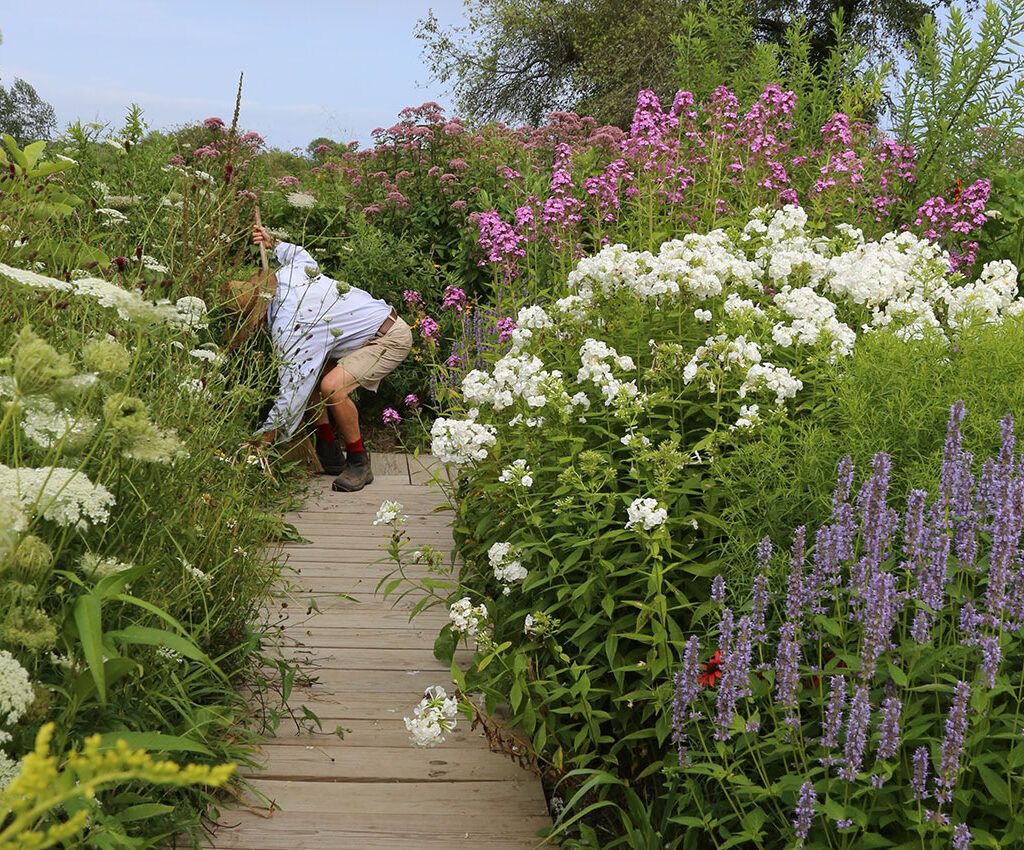
Make your walkway come alive with motion by designing a flower bed that attracts pollinators. Plant bee- and butterfly-friendly flowers like milkweed, zinnias, bee balm, and lavender. These vibrant plants not only beautify your path but also support local wildlife. Choose native species for the best success, and mix heights and colors to provide feeding opportunities for various pollinators. This idea turns a simple garden path into a buzzing, fluttering ecosystem.
14. Modern Minimalist Flower Strip
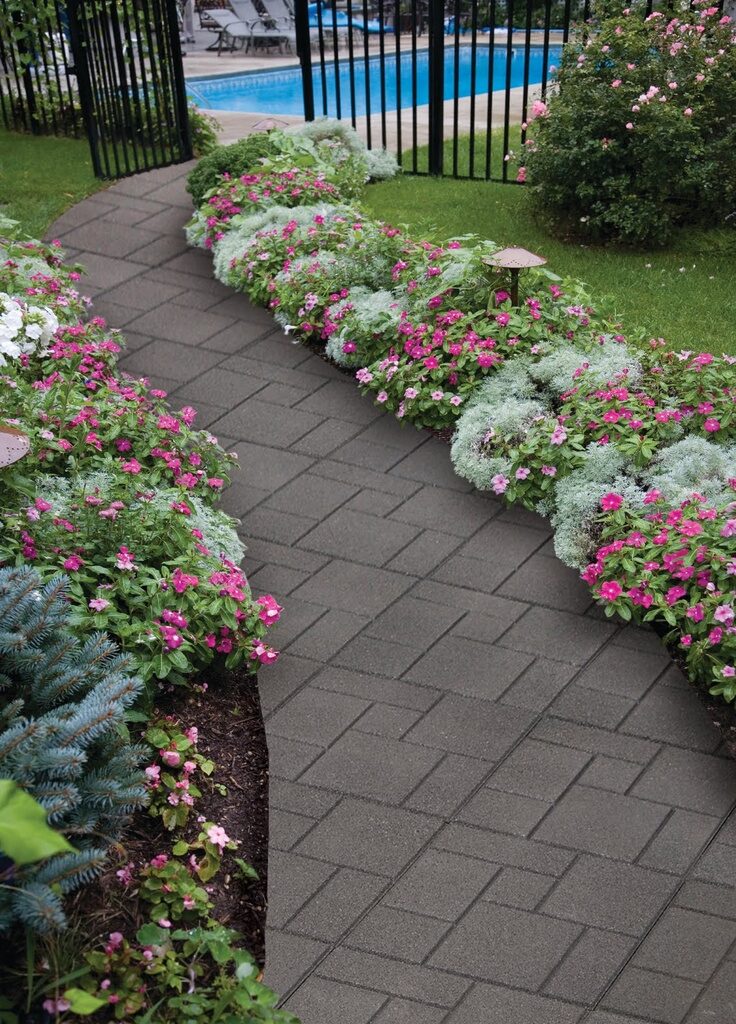
For a contemporary home, opt for sleek, linear flower beds using structured plants like agapanthus, alliums, or ornamental onions. Pair them with gravel or dark mulch for a clean, architectural look. Keep the plant selection minimal—two or three varieties at most—to maintain visual clarity. Symmetrical planting along a straight walkway enhances the modern vibe, while pops of color from the flowers keep things from feeling too sterile.
15. Raised Flower Beds Along Walkway
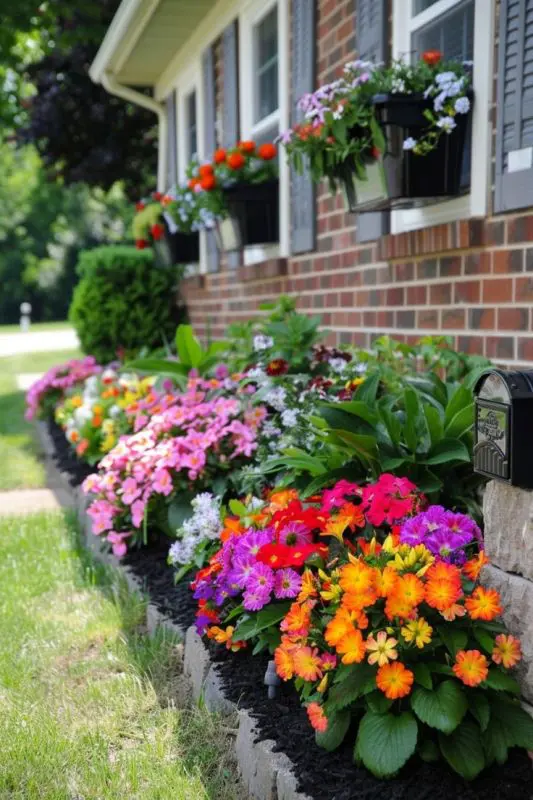
Give your garden path more structure and depth by incorporating raised flower beds made of wood, stone, or metal. These beds elevate colorful blooms like geraniums, begonias, and snapdragons to eye level, making them more prominent and accessible. Raised beds also help with drainage and soil control, allowing you to grow a wider variety of plants. This is an especially useful idea for sloped walkways or uneven terrain.
16. Curved Flower Bed Accents
Enhance the flow of your garden walkway by designing curved flower beds that follow the bends of the path. Curved beds naturally draw the eye and create a more relaxed, organic feel. Plant draping flowers like trailing lobelia, alyssum, or creeping thyme to soften the edges and enhance the curves. Add taller focal points such as foxgloves or delphiniums at intervals for visual rhythm. This idea works especially well in large gardens or winding stone paths.
17. Shade-Loving Flower Beds
If your walkway lies beneath trees or along a fence line, don’t worry—there are plenty of stunning flowers that thrive in the shade. Use hostas, astilbes, impatiens, and ferns to create a lush, layered flower bed. These plants bring texture and color even without direct sunlight. You can also mix in some heucheras for pops of purple or burgundy. This shaded setup creates a cool, calming path perfect for morning walks or evening strolls.
18. Fairy Garden Walkway
Turn your walkway into a magical escape with a fairy garden-themed flower bed. Use small-scale plants like miniature roses, mosses, violas, and thyme, and add whimsical accents such as tiny fairy houses, lanterns, and toadstools. Let the flowers spill over stones or bricks to give a cozy, enchanted forest feel. Great for families with kids or anyone who loves storytelling and imagination in their outdoor spaces.
19. Tropical Color Explosion
Go bold and bright with a tropical-themed flower bed that packs a punch of color. Think crotons, coleus, lantanas, and hibiscus in vivid reds, oranges, purples, and yellows. Mix broad-leafed plants with spiky accents like yucca or ornamental pineapple for dramatic texture. This vibrant setup is perfect for summer gardens and warm climates. Add tiki torches or bamboo edging to complete the exotic vibe along your walkway.
20. Succulent & Flower Fusion Path
Blend sculptural succulents with splashes of blooming color for a low-maintenance yet eye-catching walkway design. Use echeveria, jade plant, and aeonium as the foundation, then intersperse with bright annuals like marigolds or portulaca. This contrast of texture and hue offers a striking visual experience and thrives in sunny, dry spots. Use gravel or decomposed granite as a base to highlight the plants and support drainage. It’s a unique, water-wise way to beautify your garden path.
